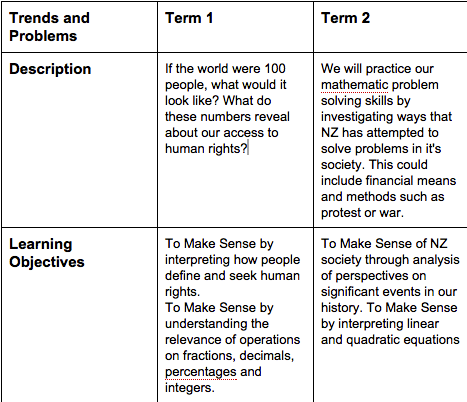I first came across the idea of enabling constraints when investigating Complexity Theory for my thesis. The book Engaging Minds gives great examples of how the right level of constraints are required to truly cause creativity to occur. This was echoed recently in a post by Tom Barrett in his post about setting the right level of constraint for learning in your class.
As this school year started, Hobsonville Point Secondary School was entering it’s 2nd year of operation and that brings new levels of constraints. 2 Year levels to plan for so double the students and some (nowhere near double) new staff on board. So, how to evolve our structures.
First of all, the 3rd generation timetable:
Specialised Learning Modules are co-taught by 2 teachers and last year had 2 teaching blocks, we wanted to deepen this so worked a way for each to have an extra hour this year. We also wanted to leverage teacher-student relationships more to enable learning so students will stay with the same teachers for a semester (2 terms) even though the focus concepts shift in the 2nd term from Culture and Diversity to Relationships.
To offer these for all students to get curriculum coverage the teacher pairings were set by senior leadership and presented to staff at the start of this year.
So, gone are the initial planning meetings of 2014 where teachers get together and discuss the focus for their learning areas and pair up based upon obvious links. My initial reaction was “ARGH! What about the authentic connection, are we losing something here!?” This may have been due to some of my pairings where SOcial Sciences are focusing on the Treaty of Waitangi in Term 2 and I needed to make it work with Algebra and Chemistry????
What has happened though is that the constraints have kicked into gear. They are proving incredibly enabling. To make these pairings work we are having to look deeper and more critically at our Learning Area focus and ask better questions of our co-teachers to more truly understand the crux of what will be taught. Perhaps the obvious connections we based our pairings on last year had made us lazy?
Yesterday I worked with Su Min, a new Maths teacher at HPSS to plan our Year 10 module for Semester 1. The focus for Maths in Term 1 is Number while for Social Sciences it is Human Rights. Term 2 Maths is Algebra and Social Sciences is the Treaty of Waitangi and Biculturalism with a wider look at perspectives on significant events in New Zealand’s history. How to make this work?
We had met for half an hour last week to get the conversations starting and then let ideas percolate for a while. Yesterday we were given 5 hours to collaboratively plan our module. Term 1 came together well with Su Min suggesting the starting point of the world as 100 people. Term 2 was tougher but then we started looking at the Waitangi Tribunal as a focus. Investigating settlement claims and evaluating value, trends in worth over time and seeing what events had lead to the settlement and investment growth or decline. So our module looks like:
The second module I am teaching is with Danielle Myburgh and is a Science and Social Science combination. Again, the meeting last week had enabled thoughts to develop over time so when we met today we made quick progress. Biology and Human Rights met together for Term 1 around the question “What makes us Human?” and the Treaty of Waitangi and Chemistry around the idea of Artefacts of our Past – that when we look at things (Scientific or Societal) now we can see traces of their development and evolution. So our module has been framed today as:
Would these have been modules that would have developed if left to form based on obvious connections? I very much doubt it. The resource constraints we face with numbers of staff, curriculum coverage etc. this year have worked to enable creativity. W ehave had to work at the planning more which means we have come up with ideas to make the situation work. Ideas which are actually looking far better than if we had stuck with what is most obvious to connect here.
This hasn’t just happened with my pairings. Many of the staff planning the last 2 days (whilst other staff are still working with our students) have made similar comments. In fact Ros echoed these thoughts on her blog last night.
Taking the constraints and using them as an opportunity to enable creative learning design (yes, after an initial negative mental outburst) is hopefully setting us up for a great 2015.
Would love to write more on this but I have 37 seconds left of my 28 minute writing constraint, so perhaps some more another time!





I’m finding tears in my eyes a lot these days. Very powerful.
Great post Steve! Pretty glad that I was channeling my growth mindset as I too had the initial outburst of it doesn’t fit! And then turns out I’m crazy excited now. Innovation is not about finding the obvious and expected, here’s to a term of innovating! #postmortem
Great post Steve. We are seeing our design thinking in action. Deep exploration and resilient ideation to find innovative solutions that blow the enabling constraints apart. #awesomeness #dt
Pingback: Powerful Partnerships in Action | Steve Mouldey
Pingback: Natural Ecosystem of Learning | Steve Mouldey
Pingback: Steve Mouldey
Pingback: What is the Essence of Your School? | Steve Mouldey
After talking about how to teach and include creativity in our classrooms at #edchatNZ conference, we came to the same conclusion, that there needs to be enabling constraints for students (and teachers) to push against to make them think outside the box a little bit more. Thanks for the great read!